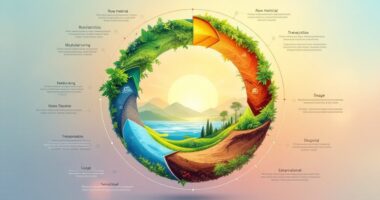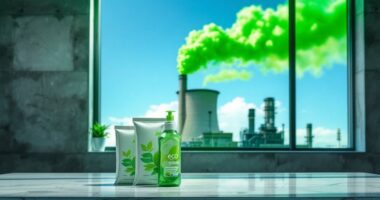Textile production leaves a massive environmental footprint, consuming staggering amounts of water and generating 8-10% of global carbon emissions. A single cotton t-shirt requires 2,700 liters of water—enough for one person’s drinking needs for nearly three years. Fast fashion has accelerated these impacts, with clothing purchases up 60% since 2000 while wear time has halved. Synthetic fibers compound the problem, releasing microplastics with every wash. Sustainable alternatives like waterless dyeing offer promising paths forward.

A single cotton t-shirt, innocently hanging in your closet, carries a hidden water footprint of 2,700 liters—enough to quench one person’s thirst for nearly three years. This startling figure represents just one thread in the complex tapestry of environmental challenges woven by the textile industry. As the second-largest consumer of water globally, the fashion sector is leaving quite the puddle on our planetary floor.
The industry’s environmental rap sheet is lengthy and concerning. Textile production accounts for a whopping 8-10% of global CO2 emissions—more than international flights and maritime shipping combined. It’s like the industry is throwing a greenhouse gas party and forgot to send the atmosphere an invitation to opt out.
The rise of fast fashion has amplified these impacts to alarming levels. With 60% more clothing purchased in 2014 compared to 2000, and consumers keeping garments half as long, we’ve created a textile tornado. The fashion calendar has exploded from two traditional seasons into a dizzying 50-100 “microseasons,” turning the industry into a perpetual motion machine of production.
Synthetic fibers, the polyester party crashers of the textile world, now constitute 60% of clothing materials. These plastic-based fabrics release a staggering 700,000 microplastic fibers in a single laundry load. That’s 500,000 tons of microfibers swimming into our oceans annually—a plastic diet no marine ecosystem ordered. The growing use of recycled polyester materials offers a promising alternative that reduces reliance on virgin plastic while maintaining performance.
While the challenges are formidable, innovation offers promising solutions. Waterless dyeing technologies, closed-loop systems, and bio-based materials are gaining traction. Alternative natural fibers like organic linen help sequester carbon while requiring significantly less water than conventional cotton. Blockchain technology is bringing transparency to murky supply chains, while regenerative agriculture practices are helping cotton shed its pesticide-intensive reputation.
Industry initiatives like the Fashion Charter for Climate Action aim for net-zero emissions by 2050, and the EU’s strategy for sustainable textiles introduces eco-design requirements. As global fiber production races toward 147 million tonnes by 2030, these initiatives couldn’t come at a more critical time. The fashion industry is finally realizing that sustainability isn’t just trendy—it’s necessary.
Frequently Asked Questions
How Do I Wash Sustainable Fabrics to Extend Their Lifespan?
Extending sustainable fabric lifespan requires thoughtful care. Wash items less frequently, airing between wears instead. When washing becomes necessary, use cold water and gentle cycles, which saves energy and reduces microfiber shedding.
Eco-friendly detergents prevent chemical pollution, while skipping fabric softeners prevents odor-trapping residue. Air drying preserves fabric integrity and saves energy. For storage, well-ventilated spaces prevent mustiness, while proper folding or hanging maintains garment shape and reduces wrinkles.
Can Sustainable Textiles Be as Durable as Conventional Ones?
Yes, sustainable textiles can absolutely match or exceed conventional materials in durability. Research shows organic cotton lasts 20-30% longer than conventional cotton, while hemp boasts three times the tensile strength of regular cotton.
Recycled polyester maintains the same durability as virgin polyester, and innovations like ECONYL match virgin nylon’s performance. Materials like Tencel and Modal even surpass conventional cotton in longevity. The key difference? These durable options come without the hefty environmental price tag.
Are Natural Dyes Better for Sensitive Skin?
Research suggests natural dyes are indeed gentler for sensitive skin. Unlike their synthetic counterparts, they’re free from harsh chemicals and toxins that can trigger irritation. These plant-based colorants offer bonus benefits too—antimicrobial properties, UV protection, and even medicinal advantages from their botanical origins.
However, they aren’t perfect; color consistency can be challenging, and availability remains limited. For those whose skin throws a tantrum at the slightest chemical provocation, natural dyes represent a soothing alternative worth exploring.
What Certifications Indicate Truly Eco-Friendly Textile Products?
Several certifications reliably identify eco-friendly textile products. GOTS verifies that textiles contain 70-95% organic fibers with restricted toxic chemicals and fair labor practices.
Oeko-Tex Standard 100 tests for harmful substances in all textile components. Bluesign assesses entire manufacturing processes, focusing on eliminating harmful substances and resource efficiency.
Cradle to Cradle evaluates products on material health, reuse, energy, water, and social fairness with certification levels ranging from Basic to Platinum.
How Much Water Is Saved Using Recycled Fibers?
Recycled fibers deliver impressive water savings across the board. Jeans made with recycled cotton save up to 220 liters per pair, while recycled polyester uses a whopping 90% less water than its virgin counterpart—just 3 liters versus 60 liters per kilogram. These savings stem from bypassing water-intensive processes like growing cotton or manufacturing virgin synthetics.
When scaled up, the numbers become staggering: 100,000 recycled cotton jeans save enough water to fill eight Olympic-sized swimming pools.









